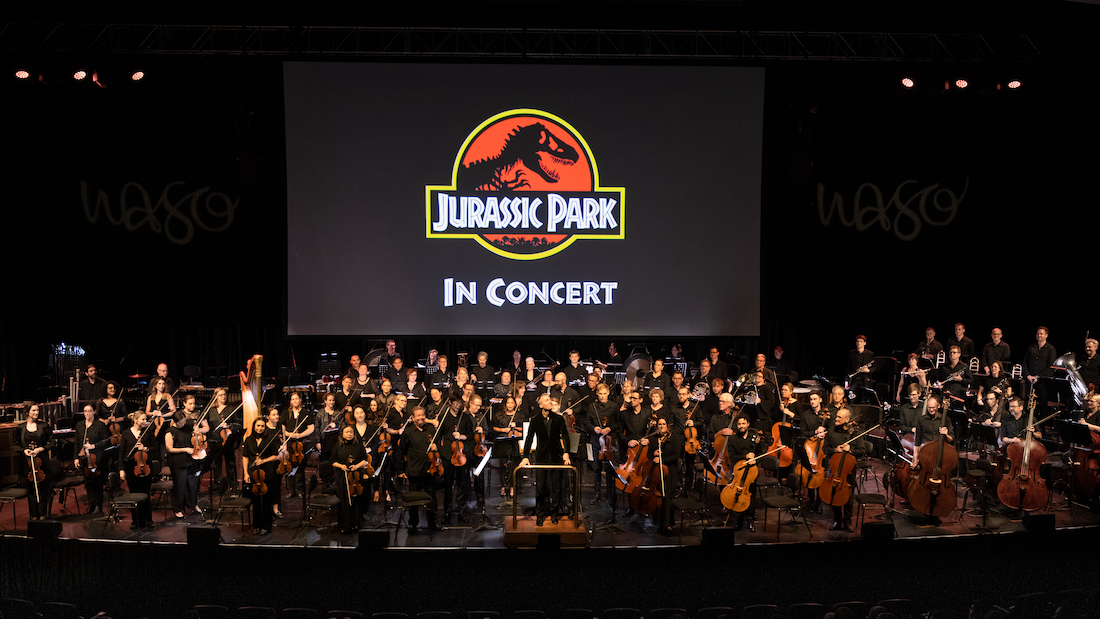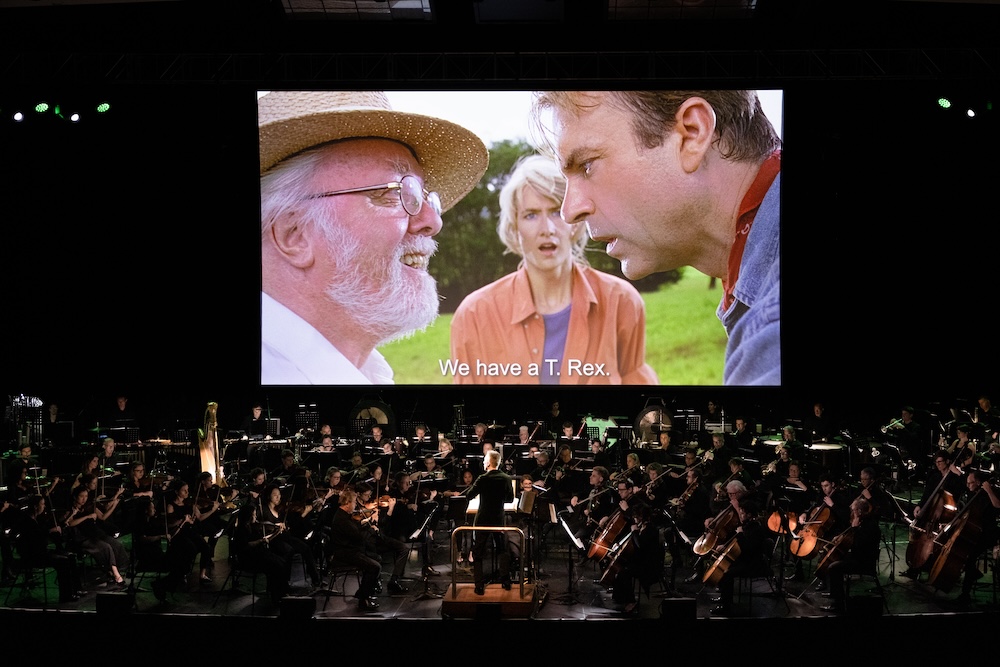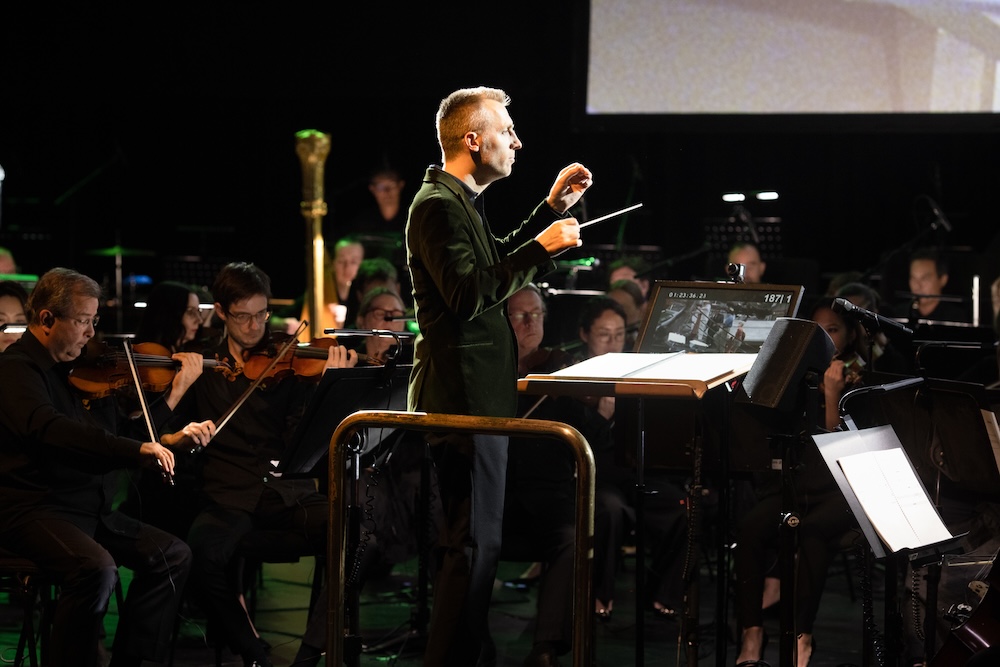
Review: WA Symphony Orchestra’s Jurassic Park in Concert at Riverside Theatre
WA Symphony Orchestra’s Jurassic Park in Concert at Riverside Theatre
Saturday, March 22, 2025
After two weekends in a row watching WASO perform in Winthrop Hall, it was a total turnaround to see them play live to the film of Jurassic Park. From the sublime Beethoven to the ‘ridiculous’ Strauss to the sensational John Williams and Steven Spielberg. What a journey. It was even more impressive to witness it amid a two-thousand-strong crowd. The musicians must surely have felt the love.
The audience lapped it up. Unlike the classical custom of holding back the applause until the very end, like a rock concert, they cheered and clapped every stirring tune—which was a bit weird when some of the tunes ended mid-scene. By the time the final credits rolled, it was more like a jazz concert with the audience applauding every featured passage—especially the rousing horn part.
This was a world away from the traditional response the orchestra received the previous week. Although the applause for Die Fledermaus had been thundering, heartfelt, and deeply appreciative, this was totally wild. But then there were few frocked-up grand dames in the Riverside Theatre—this was more like a footy crowd—families and groups of mates out for a spectacular night.
John Williams’ Jurassic Park score is truly thrilling. His main mission in film is to stir up emotion. With 54 Academy Award nominations under his belt, second only to Walt Disney, he knows damn well how to hit all those spine-tingling buttons. As Alfred Hitchcock might have put it, he plays an audience’s emotions like an organ grinder hitting the keys. To experience this through the voice of a live orchestra instead of a cinema’s speakers takes it onto an altogether higher plain. The sound was tremendous.
But then Williams is renowned for his complex orchestration. With his blend of romantic, impressionist, and atonal styles, he weaves the full range of orchestral instruments into the most dramatic and facile tapestry. You really have to see it played live to appreciate the subtle complexity of his immense craft.

Even so, there is an inherent difficulty in watching a film with a live soundtrack. If you focus on the music, you miss the movie, but if you are drawn into the action, you quickly forget that the score is being played live in front of you. In the end, you tend to jump between the two. When you remember the band, you pull out of the film. This is useful in the scary bits: ‘Ooh, look at that eerie green light bouncing off the shiny slide trombones as they swell and shrink!’
When compared to concert compositions, there is an inherent paradox in soundtrack music. A concert piece is akin to a starring role, while a soundtrack, even at its most artful, is always only a support, but one member of the chorus, to mess up the metaphors.
The best soundtracks should not draw too much attention to themselves but instead disappear beneath the surface of the film to heighten the sentiment of the story. Concert music, on the other hand, evokes a complex, free-standing emotion unaligned to any specific situation. In that way, pure music helps us render the landscape of our lives and can become a deep part of our own inner makeup. A soundtrack, no matter how stirring, remains primarily aligned with its film—at least that’s what it’s designed to do.
Conducting an orchestra through a live score takes a special skill, and guest conductor Nicholas Buc is adept at it. Renowned for his live film concerts (Star Wars: the Last Jedi, Harry Potter and the Deathly Hollows Pt II), Buc is an award-winning composer, conductor and arranger. He has performed with all of the Australian symphony orchestras and collaborated across genres with such luminaries as Winton Marsalis, Nick Cave and Tina Arena. His own works have been performed by the Sydney Symphony Orchestra, the Melbourne Youth Orchestra, and the Sydney Philharmonica Choirs, while his Daughter of the Inner Stars has its North American debut in May this year. He was certainly the artist to bring Jurassic Park to life.

On another level, there is a historic logic in the WA Symphony performing a movie soundtrack.
Before the ABC moved out of its old Adelaide Terrace HQ, the Basil Kirke auditorium on its ground floor, WASO’s old rehearsal room, was sometimes hired by Hollywood filmmakers to record soundtracks. Some of John Williams’ famous scores were recorded there. This may seem bizarre but is not, given Basil Kirke’s stature as a revered recording space. Identical to Studio 1 at Abbey Road, with its thirty-foot-high ceilings, it is (or at least was back in the day) one of the three largest recording studios in the world. Designed specifically to accommodate large classical orchestras, what better place to record a soundtrack, especially when Abbey Road was booked up? With a world-class symphony orchestra on hand to play it, the prospect is even more appealing.
Although the rest of the original ABC building has been replaced by a high-rise apartment block, due to its heritage listing, the Basil Kirke remains intact. Alas, it hasn’t been used in more than twenty years. Someone should really get onto the property managers—the room remains one of Perth’s golden cultural assets.
Among the many pleasures of symphonic music, a highlight is seeing such a large number of people working together in the moment to create a single unified work of art. It’s not merely the logistics of organising it but the collective concentration required to bring it off. One player out of place, and the whole thing collapses. Little compares to it.

Spread across the giant stage of the Riverside Theatre the other night, the orchestra seemed huge. Eighty-four players is a big band, not the biggest WASO can be—Mahler and Richard Strauss require up to 100 musicians for their larger symphonies—but certainly big. In many ways this seemed even more impressive, as the players could spread their arms out and weren’t sardined onto the smaller stages of the Perth Concert Hall and Winthrop Hall.
In keeping with the code of the venue, the players were dressed informally. The ballgowns, white ties, and tails gave way to the universal black shirt and trousers of gigging musicians. Buc was the only one wearing a jacket, but then conductors always reserve the right to dress differently. Even the WASO principal conductor, Asher Fisch, in high classical mode, prefers a silver tie on a black shirt to the traditional cummerbund.
Jurassic Park in Concert was a true performance for everyday people, and the everyday people in attendance truly appreciated the performance. The exuberant afterglow of the concert was only partially dulled by one of the cellists hoiking her instrument off to catch the late bus. When asked if she’d felt the love, she replied that it wasn’t directed at her. True. But then that’s the price musicians pay for playing in a grand symphony orchestra.
WASO will be back at the Riverside with Buc in June performing The Music of John Williams and again in July for Star Wars: The Last Jedi. In the meantime they have a turn with the WA Opera and a good half dozen classical concerts. You can see them this coming week performing The Pirates of Penzance at the Maj, and a fortnight hence back in Winthrop Hall playing Mozart with guest director Satu Vänskä.
As the state’s premiere musical ensemble, WASO certainly earn their keep, delivering one amazing concert after another weekend about.
IAN LILBURNE
